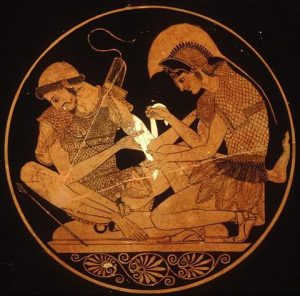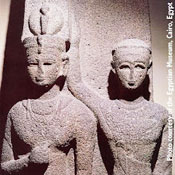
Achilles bandaging the wounded Achilles binding up the wounds of Patroclos (Athens, red-figure vase, 500 BC -now in Berlin)
All over the world, the time between 500 BC and 1 BC was a time of unification. People traded with each other. And they built big empires. Cyrus the Great’s unification of the Persian Empire brought peace and stability to Central Asia and West Asia. Peace encouraged the growth of the Silk Road. Everybody wanted things to sell on the Silk Road, so they invented a lot of new things to sell. In India, people started to make high-quality steel, and expanded their pearl-diving industry. India also exported cotton cloth, and medicines.

Pazyryk rug (ca. 300 BC)
In the Persian Empire, people started to blow glass, and knotted fancy Persian carpets. They raised purebred horses to sell. In China, the silk industry expanded. Women used newly invented steel needles to do fancy embroidery on the silk robes. Metal-workers figured out how to do silver-plating and gold-plating. In Europe, the Greeks exported wine and perfume, and fancy pottery. In Central Asia, someone invented camel saddles about 200 BC. That made trading easier, too.

A Moche woman and child
Soon other empires formed. In India the great general Chandragupta formed the Mauryan empire in the 300s BC. That empire got even bigger under Chandragupta’s grandson Ashoka. In China, first the Chin Dynasty formed and then the Han Dynasty. Across the Pacific Ocean in Central America, the Maya and the Zapotec also built strong empires.
In Peru, the Chavin collapsed and the Moche and Nazca formed new empires. Over in Brazil, the Tupi settled along the Atlantic coast. Further south some Tupi split off as the Guarani. In North America, the Hopewell culture united people from Louisiana all the way north to Ohio and Wisconsin, trading in canoes up and down the Mississippi and other rivers.

Hopewell tobacco pipe
Across the Atlantic, in Africa, some Bantu people from West Africa began to spread out across Africa, bringing their language and their iron tools with them. North of the Sahara, the Carthaginians built another empire all along the coast of North Africa and Sicily. In East Africa, Meroe got more and more involved in trade with West Asia and India.

Queen Shanakdakhete of Meroe, in Sudan (about 150 BC)
In Europe, the Athenian Empire united Greece, only to be conquered in turn by Alexander the Great, who took over the Persian Empire to unite Greece, Egypt and West Asia. The Roman Empire formed and defeated Carthage in the Punic Wars, and then conquered Greece and Egypt too.
To stand against these new empires, people also started new religions: Taoism and Zoroastrianism got much stronger, while Buddhism took over India and Central Asia.

Copy of Eratosthenes’ map of the world
As people got richer, they also got more educated: in China, the government ran free schools. Buddhist universities got started at Taxila and Nalanda.
Socrates, Plato and Aristotle opened schools in Athens. Greek theater got started, and Herodotus wrote his history. The University of Alexandria started up in Egypt. In Egypt, Eratosthenes discovered that the earth was a sphere, and how big it was, and people argued about whether the earth went around the sun.
Euclid wrote mathematical proofs. Doctors experimented with dissection to find out what was inside people. In India, scientists invented modern numbers and the waterwheel. In China, mathematicians were solving simultaneous equations. Everybody was talking to everybody else, and sending ideas back and forth.